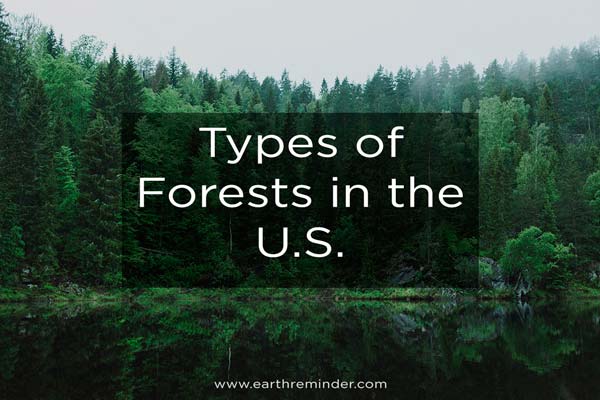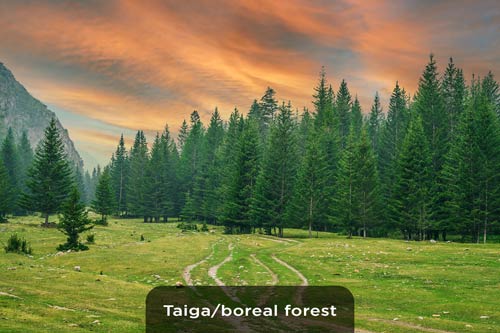Types of Forests in the USA
The United States of America holds a huge green treasure covering roughly 36.21% of the US territory. About one-third of the USA is covered with forest, about one billion acres of land covered with trees. With this wealth of vegetation, it is not surprising that different classifications are types of forests in the U.S.
The most heavily-forested regions of the United States are Maine, New Hampshire, American Samoa, the Northern Mariana Islands, and West Virginia. In contrast, the least heavily forested regions are North Dakota, Nebraska, and South Dakota.
The advantages and need for forests are something so basic that it should not need any discussions. Different trees provide us with a variety of essentials-be it food or fuel. Forests are the basis of our being as the fresh air we breathe is its kindness.
It is a big country spread across millions of acres of soil; thus, the weather, landscape, and soil vary, causing the diversification in classifications. The USA’s forest’s diversity is its biggest treasure, which is celebrated by the citizens due to its uses and beauty.
Forests are distinguished due to the unique climates and the geographical directions of their existence. The forests in the U.S. fall under three broad categories as: Tropical forests, Temperate Forests, and Boreal Forests.
Table of Contents
Types of Forests in the U.S.
Tropical Forest
Location:
- The US’s tropical forests lie in the south of this huge territory and the Hawaii and Puerto Rican regions.
- The name tropical forests itself suggests that these woods lie near the tropic and thus are abound in vegetation that needs warm climates and is home to abundant flora and fauna.
Description:
- Tropical rainforests are rainforests whose thick canopy thrives in the moist soil of the regions near the Tropic of Cancer or Capricorn.
- The fauna consists of endemic species such as fungi, mosses, snails, birds, and other wildlife.
- The lush flora also includes trees draped with vines, orchids, ferns, and mosses; other than these, the canopy includes miles of acacia koa trees, native Hala, hau, loulu fan palms, kukui,papala shrubs, lehua trees, kauli olona, and so many other native plants.
Popular Sites:
- In these regions, popular forests are the Florida Everglades, Louisiana Swamp, and El Yunque of Puerto Rica.
- The dense foliage is also celebrated for hikes and guides tours with visitation features like bridges, walkways, and trek destinations.
Temperate Forests
Location
- This type of forest in the U.S. lies in the north to tropical forest and near the east coast, covering the next ring of latitude, like in California and Colorado.
- The sun is less direct in these regions, and the weather is cooler. The change in seasons is more evident in these types of the jungle, and thus the flora differs in different climates and temperatures.
Description
- Temperate forests are celebrated in the U.S. as almost all states have one of these treasures, which provide them with fresh oxygen to breathe. These forests are special due to the presence of both deciduous and evergreen trees.
- Spring brings in flowering dogwood and black cherries in addition to the all-year-round canopy f coniferous trees such as cedar, fir pine, and spruce.
- Summer is the season of maximum gain for people living near the forests as the oxygen content is high, and the fiery forest display of the scheduled fall is highly anticipated.
- Even in winters, these forests don’t dissatisfy anyone with their ash, maple, and gum trees as they reveal their striking change in color and the familiar fragrance.
Popular Sites
- The Sierra Nevada around the Lake Tahoe and Pando Forests on the East Coast are two very popular east coast woods. Other celebrates temperate jungles are the Redwoods of California and the Ponderosa Pine forests.
- These forests are popular for camping and trekking all around the year, not letting anyone regret the missed season for outdoor fun. The fall season is the prettiest time of the year, though, as the forests do put up a splendid show of colors and smells satisfying both the eyes and the olfactory senses.
Taiga Forests
Location
- Though not completely native and of extensive reach in America, taiga forests still exist in some regions of the Sierra Nevada Mountains and northern Appalachians.
- These forests lie in the northern regions of the United States of America and are also known as the Boreal forests.
Description
- Taiga forests are not a very ancient green coverage type, rather relatively recent, existing for about 12000 years now, but still are known as the world’s largest biome.
- Taiga forests are mainly based in tundra altitudes with extremes of temperature. The long cold winters are the dominant feature of these woods, and this climate itself is the trigger for boreal vegetation growth.
- The taiga fauna significantly includes evergreen or coniferous trees such as a mix of spruce, birch, pines, larch, and alpines. They also consist of some deciduous trees such as oak, maples, alder, willow, and poplar.
- Taiga forestation is very prone to forest fires due to the extremes temperatures and the cold winds of the areas. High-intensity crown fires are common in these fires.
Popular Uses
These types of forests in the USA are not popular for travel or visits due to the harsh climates and vicinity. But Balsam Fir, an abundant species in this Taiga region, is used for festive purposes.
This is the same plant used as Christmas trees during the year-end celebrations of the holidays. It is the classic home décor because of its fragrant attributes and has been the centerpiece for the celebrations. These trees are also used for the wreaths and mistletoes hung for the festivities.
All 56 states of the US territory have some sort of coverage of the green foliage. These types of forests in the US can be divided into various categories on a myriad basis.
Another way of categorizing the forests would be by species, which would need a broader arena of description.
This article has subdivided them region-wise as this makes the distribution clear based on the location and climate.
The USA is a hugely forested region, even more than Europe. Protecting these regions of green lush should be our major priority.
The diversity of the forests is worth celebrating, rely on the variety of trees found in these jungles. Our main goal as the world’s citizens is to protect the bio-diversity due to this rich spread of foliage.
All the different types of forests in the US have special characteristics that make them special and valuable not only for the country but also for the world as the forest covers reduce by day due to mankind’s increasing needs.



